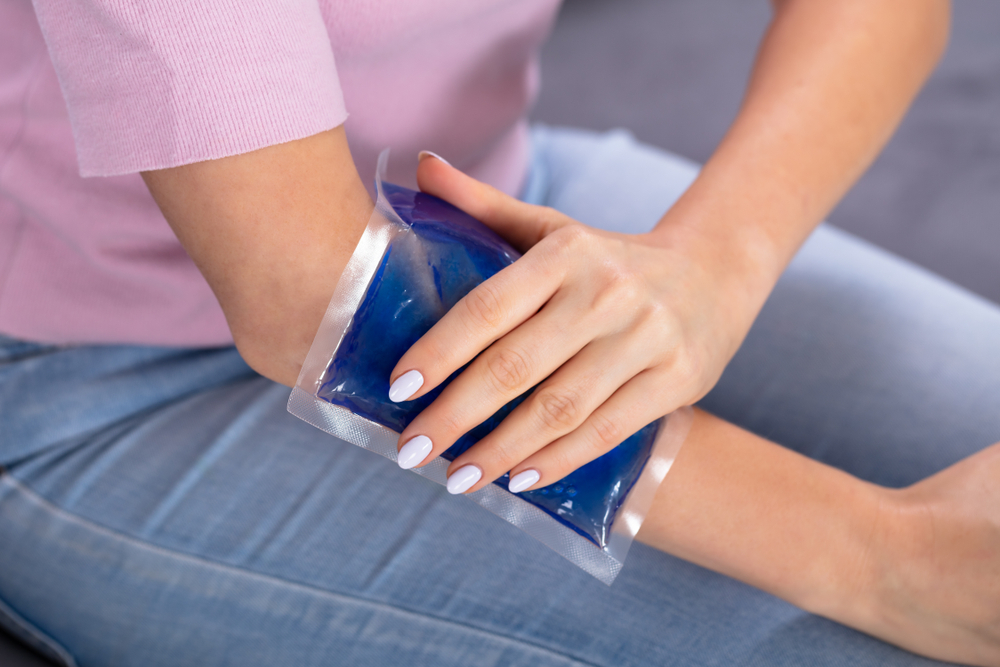How to Feel a Vein to Draw Blood
Getting blood drawn: Side effects
In general, it's common to have blood drawn without serious side effects. There are cases, though, where you may experience some or all of the following symptoms:
Pain in the arm after blood draw
Pain at the site of needle insertion is the most common side effect of venipuncture. The degree of pain varies from person to person, but it tends to be most noticeable when the needle initially pierces the surface of the skin and then subsides once the syringe is docked into the vein.
The pain or discomfort of a blood draw can increase in cases when a doctor or nurse makes repeated attempts to puncture a suitable vein. This is often the case with children or elderly patients, in patients whose veins are unusually thin, or those who have low blood pressure.
It's also common for bruising to develop after venipuncture — and although this is harmless and usually fades with time, it can be upsetting to some people, particularly if the bruising occurs beyond the point of needle insertion. The more experienced the nurse is, the less likely it is that you'll end up with bruising.
Bruising typically appears around the site of needle insertion (for instance, on the inside of your elbow or wrist), but can spread beyond this location. This is completely normal and should not cause you any concern. Although bruising can be unsightly, it should resolve over the next few days without intervention.
Very rarely, pain or discomfort in your arm, hand, or fingers can indicate inflammation of the arm, a tendon or nerve injury, or the puncture of an artery. The staff at the clinic or hospital where your blood draw takes place will be trained to recognize any of these uncommon side effects and offer you the most appropriate treatment and advice.
Contact a medical professional if you experience any of the following symptoms after a blood draw:
- Stiffness, weakness, or aching in the arm
- Pain that worsens when you move the arm
- Severe or worsening tingling in the arm
- Severe or worsening swelling in the arm
- Redness or inflammation in the arm
- Change of color or temperature in the arm or hand
Take a quiz
Find out what you can do with our Health Assistant
Feeling light headed after blood draw
A small minority of the population will feel faint after a blood draw — this can include feeling light-headed, dizzy, hot, sweaty, or nauseous. An even smaller number may actually faint. Even though this can be an unpleasant experience, it's nothing to be worried about and the staff at your clinic or hospital will be well prepared to deal with cases like this.
Feeling tired after blood draw
Even if you don't feel light-headed or faint, venipuncture can still be a draining experience and you may feel tired afterwards. In most cases, this will pass gradually — but be sure to seek medical advice if your fatigue does not improve or worsens over the following few hours.
How to prevent side effects and fainting from a blood draw

Side effects like pain and bruising after a blood draw are common, but should not cause you great concern. Most symptoms will resolve of their own accord without intervention from you or your healthcare provider. However, there are a number of precautions you can take to minimize any discomfort you experience:
- Notify staff. If you've found venipuncture to be challenging in the past, make sure that you mention this to the staff at your clinic or hospital. Your doctor, nurse, or other health care professional will do their best to minimize any pain or discomfort, and may be able to offer an anesthetic to help you. Alerting the staff to a history of fainting will also help them to anticipate this possibility and respond appropriately.
- Treat bruising with R.I.C.E.
–Rest: Avoid heavy lifting (for instance at the gym or when carrying groceries) for at least 36 hours after your blood draw, but gentle exercise can still be beneficial to recovery.
–Ice: An ice pack or package of frozen vegetables over the bruise and wider area is most effective immediately after venipuncture. Avoid direct contact with the skin by wrapping the ice pack in a clean cloth for about 20 minutes.
–Compression: Apply direct pressure to the area of the bruise by pressing down on the ice pack.
–Elevation: Although this is not always practical, if possible, try to elevate your arm on a pillow or other support.
- ...and then heat. After 36 hours have passed, apply a warm cloth to the affected area for 10 minutes and continue to do so 2–3 times a day. This will increase blood flow to the area of the bruise and encourage normal color to return.
What not to do after getting your blood drawn
Most people experience little or no lasting side effects following venipuncture, but it's helpful to keep the following restrictions in mind afterwards:
- Avoid alcohol, strenuous exercise, and hot baths and saunas
- Avoid standing for long periods
- Avoid activities that would be dangerous if you fainted
- Let family and friends know that you've had blood drawn and have been feeling unwell or faint so they can respond appropriately if your condition worsens
How to Feel a Vein to Draw Blood
Source: https://flo.health/menstrual-cycle/health/symptoms-and-diseases/relieve-blood-draw-symptoms
0 Response to "How to Feel a Vein to Draw Blood"
Post a Comment